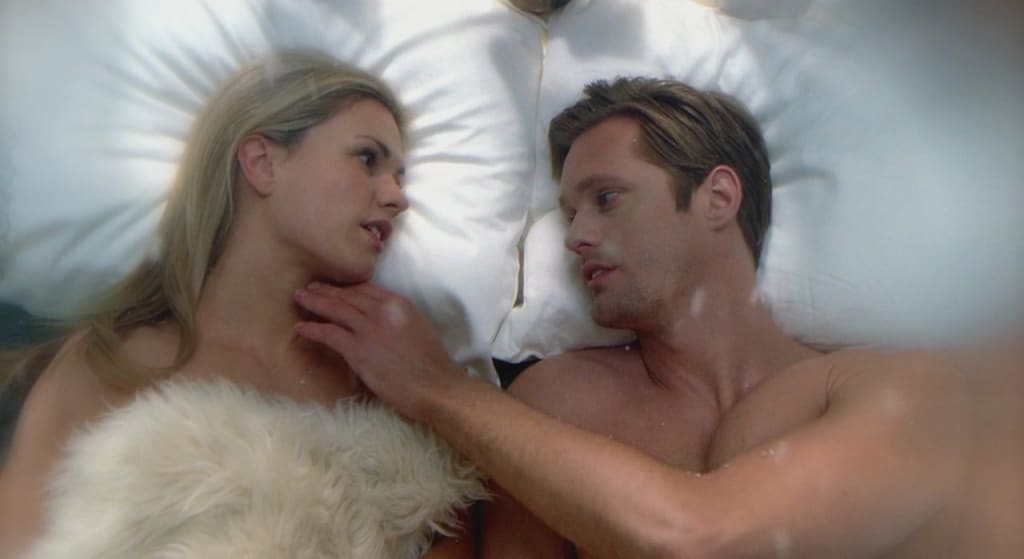Why Are Vampires Seen as Sex Objects?
Blood and sex don't always go hand in hand, which is why many people wonder "why are vampires seen as sex objects?"

When was it that rotting flesh devils who sucked a person dry of blood until their lungs rasped out their last became sex objects? Vampires and sex seem intertwined together. Before Twilight, before Anne Rice, and before Dracula, vampires were seen as devils or demons. Soulless husks who preyed on the living.
So why did we turn this into a sex object? Vampires have a long history, one full of nightmarish horror and grotesque bodily mutilation, but, when one takes a closer look, it seems inevitable that these blood sucking vampires are seen as sex objects.
Lilith

Lilith - True Blood
One of the earliest vampire myths is the story of Lilith. Though Lilith existed in various forms throughout folklore prior to the birth of Christ, the most familiar and wide-known variety of the Lilith story comes from Judaic folklore.
According to Hebrew legends, Lilith was Adam's first wife (as in Adam and Eve). Like Adam, she was crafted by God from clay. As Lilith saw herself as equal to Adam, when the two would lay together, she tried to lay on top. Because of this, Adam, who apparently couldn't handle Lilith (a woman) treating him as he treated her (like a woman), he cried to God, who banished Lilith and her children, the Lilin, to the world beyond Eden. God crafted woman from Adam's rib, thus making woman "lesser" than man, while Lilith, angry, went on an eternal killing spree against the sons of Adam and Eve using her sensual charm.
You can no doubt see the sexual politics at play. You can almost hear the story teller shouting, "Women folk, how dare you think you're at a man's level?" But what's interesting here is that Lilith, in the later half of the myth, takes the form of an entity known as the succubus. A succubus – and its male counterpart, the incubus – prey on innocent Jews and Christians by draining them of energy through the act of sex.
We honestly draw far more of our modern vampire myth from the succubi and incubi. During the Medieval Era and Renaissance Era, both were far more well-known than the vampire, which primarily was feared in Eastern Europe and, interestingly enough, China. In both of those cases, the vampire existed as a reanimated corpse that would prey on the living. More like a ghoul or zombie or wight.
But it was the succubus that would sneak into a bedroom at night, straddle its victim, and seduce them... all in order to feast upon their physical energy. Remember, this was a time where sexual appetite was seen as wrong. If a woman became pregnant out of wedlock, you couldn't just have a shotgun wedding. You'd have to join a nunnery or pretend that a demon ravaged you to excuse it all away.
Carmilla and Dracula

Carmilla
Most vampire stories told today – if not all of them – have more in common with the succubus and incubus myths primarily because two novels came out that appropriated the imagery and iconography surrounding these demons and just planted the foreign name "vampire" over it.
Two of the 19th century's most important works of vampire literature are Sheridan Le Fanu's Carmilla and Bram Stoker's Dracula, both of which pinned vampires as sex objects. And both of them use the vampire as a metaphorical fear of sexuality in the lens of the unknown. In the Victorian Era, sex was subdued. It was seen as shameful to be overtly sexual.
Even more so if you directed your sexual attraction toward the same sex.
In Carmilla, a young maiden is befriended by a beautiful woman who behaves in a predatory manner. A luscious, sexual predator. It is obvious to any reader familiar with vampire lore that this beautiful stranger is an ageless vampire.
But the fact that it is a woman laying in bed with another woman that scandalized audiences at the time. In those times, purity was deemed highly important, and the vampire Carmilla is seen as a form of temptation for the young heroine. To add to the degree of sexuality, the vampire bites her bosom, a far more sexual place than the hickey-prone neck.
This turned the vampire from a rotting corpse into a succubus-esque sex object.
These ideas were codified in Dracula, where the titular vampire is seen as a foreign demon. Essentially, Dracula is the immigrant coming to England to take over things. In essence, the fear of foreigners, given tangible form. Except instead of an Eastern-European man hoping to make his fortune, Dracula wants to suck your women of blood to turn into his bloodthirsty slaves.
Curiously, Dracula doesn't bite any men. His brides threaten Johnathan Harker, and the vampire-version of Lucy preys on both children and her suitors, but never does Dracula himself attack another man the way that Carmilla attacked members of her own sex. The novel is very heteronormative that way.
The scene where Dracula baptizes Mina in his blood is particularly gruesome and sexual. Dracula cuts open his breast after sucking Mina's blood, and forces her to drink of his life fluid. It's very much an exchanging of fluids, akin to the exchange of sex juices. It's a perversion of normal sexual behavior.
In both novels, sex is shown as a form of corruption that distorts and twists good souls to do bad. Sex is evil. Virginity is good.
That's what people believed in the 19th century.
20th century? Well...
Anne Rice

Image from Interview With The Vampire
Writers tried to maintain the element of horror about the vampire. Nosferatu turned the vampire into something akin to vermin, and both Universal and Hammer Studios, when adapting Dracula, tried to make Dracula scary (though, instead, he turned out really cool). But the fear surrounding vampires – and, to an extent, the other monsters of gothic fiction – steadily decreased. The public's interest never waned, but they had become too familiar to become scary, so later writers, starting really around the 70s, attempted to humanize them, to make them appealing.
How else do you humanize a thing unless you also make it sexy?
Now, Hammer Studios did release several vampire films in the late 60s to early 70s featuring curvacious women with hefty boobs, and they did fine in that they made money. Women there were objectified and more sex objects than people. They didn't have much initiative other than to be bitten or killed... until they became vampires. Then, they became in charge of their lives, even if they took charge to seduce and kill people.
Oddly enough, in the 60s and 70s, what had scared people centuries before (a woman taking charge sexually) stopped being scary, and started being erotic and sexy. The scary vampire had become the sexy vampire, and here we really experience vampires seen as sex objects.
But that didn't really do it for a lot of people. They found these films demeaning (and, honestly, fairly so). They needed high art. They needed literature.
Enter Anne Rice, who really is responsible for the sexy vampire in modern culture. Taking elements already present in the myth (the succubus myth, Carmilla, Dracula...) she created possibly one of the greatest vampire novels of all time in the 70s, Interview with the Vampire. Here, the vampires are panromantic immortals who are at once tormented and empowered by their cursed immortality. Though Louis is the protagonist, the real scene stealer – and eventual star of Anne Rice's vampire novels – is Lestat. Lestat is powerful, cool, and just the most awesome character in the world. We're talking about a vampire who lives into the 80s, and decides to become a rock star. The guy is cool.
Characters who can feel sexual attraction and torment tend to also inspire similar feelings of desire in those readers. Many readers found themselves rather aroused reading about these sexy vampires holding one another and lusting after one another...
Due to the series's pro-LGBTQA+ themes in a time period starved of speculative fiction featuring these themes, Anne Rice was simultaneously associated with sexual liberation and sexual deviation from audiences. LGBTQA fans could identify with the characters, who found attraction in all physical forms, while less progressive (bigoted) people found themselves uncomfortable reading the books. Either way, both parties acknowledged that the books were very sexual in nature.
Anne Rice's influence can be felt in all over vampire fiction, from The Lost Boys to Bram Stoker's Dracula to Anita Blake... and, yes, Twilight.
...Twilight...

Image from Twilight
You know the plot to this book series. It is the teenage paranormal romance story... and by that, I mean it sold well because it dumbed down the already simple idea of the vampire.
Twilight did more bad for vampire fiction ultimately, as it flooded the market with half-baked paranormal romance novels that really didn't bring much to the table. However, it did get a lot of teenagers reading young adult fiction, so I can't get too angry at it.
Twilight, for many people, may have also caused enough backlash to make people crave for more dangerous vampires. The film 30 Days of Night came out in part thanks to this backlash, and those vampires sure as hell aren't seen as sex objects.
But it is thanks to the paranormal fiction boom following Twilight that the sexy vampire thing really took off in modern pop culture. Wanna know good vampire fiction from bad? In good vampire fiction, the vampire is still monstrous. In bad fiction, the vampire is a lost puppy begging to be loved.
But the real sexy thing about vampires is that element of danger. Fear and sex go hand-in-hand. That's why horny couples go watch horror movies instead of, say, Adam Sandler movies. Being afraid makes you want to hold someone for comfort, and, once that fear is released, you feel a sense of strong need for the person you're holding. Maybe it is that element of fear that makes vampires such popular sex objects.
About the Creator
Anthony Gramuglia
Obsessive writer fueled by espresso and drive. Into speculative fiction, old books, and long walks. Follow me at twitter.com/AGramuglia






Comments
There are no comments for this story
Be the first to respond and start the conversation.